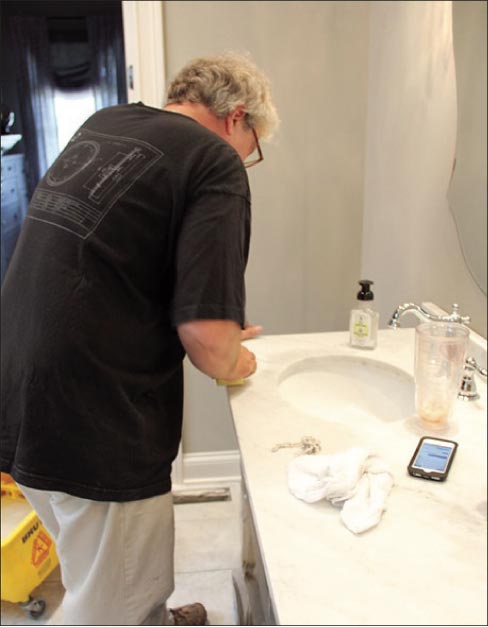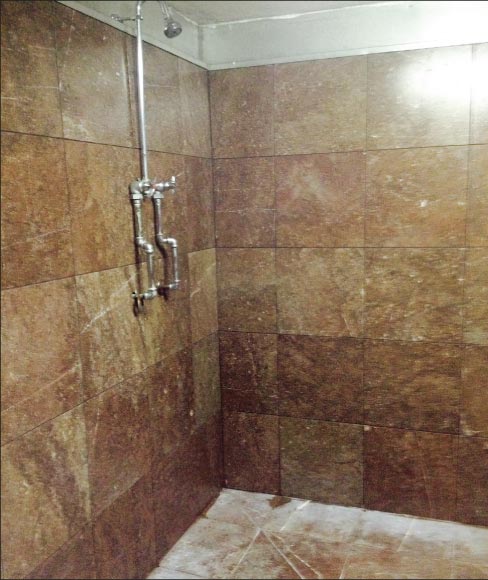Stone Restoration and Maintenance Corner: Shower and Bath Restoration
Bob Murrell
M3 Technologies
 |
|
Above: Spot honing a marble vanity top. Common toiletry spills on vanities, including cosmetics and hairspray can etch marble. |
 |
|
The bathroom can be a battleground for stone surfaces, and most customers don’t call you until these issues have caused problems and the stone is in need of a little – or a lot of – restoration, like this shower. Above and below: Before and after deep cleaning shower walls and restoration. The floor needed to be ground and repolished. |
 |
Thanksgiving is almost here and Christmas is right around the corner. I have much to be thankful for like my health, a beautiful family, and to be living in the greatest country the world has ever known!
In this month’s article I would like to discuss how to restore and maintain showers and bathrooms. Sounds simple right? Well, these areas can be some of the most frustrating zones to refinish and can certainly require a higher level of maintenance involvement.
Showers for instance are subject to shampoos, soaps, body washes, conditioners, and of course, the minerals present most water supplies. All of these tend to accumulate on the vertical and horizontal surfaces of the shower, and also vanity tops. Sounds disgusting, and if left untreated for too long of a time, it can certainly become unsightly, for sure. And it gets worse: don’t forget that guys tend to have better aim in the woods than we do in the bathroom, so urine is also a common cause for etching and staining.
Let’s take a closer look at some of these beauty products and what their chemical composition is. Normally some type of surfactant (wetting agent) is combined with other products to produce the desired effect for a specific lotion or soap.
Soaps are salts of fatty acids and are typically made from either sodium hydroxide or potassium hydroxide (strong base/alkaline) along with some type of fats and oils (either animal or vegetable based). The alkaline solution reacts with the fats, and a chemical reaction called saponification occurs.
Shampoos are typically made from sodium laureth sulfate as the main surfactant and possibly cocamidopropyl betaine (derived from coconut oil) as a secondary surfactant. These surfactants are designed to remove soiling and oils from human hair.
Conditioners are generally made to attract and retain moisture and are called humectants. They would be considered the opposite of desiccants, although both attract moisture. Conditioners are designed to lock in moisture to the keratin in the hair. They can be made from glycols, urea, aloe vera, honey, almond oil, eggs and other humectants. They are sometimes also used to reinfuse proteins and control pH balance. This is accomplished by adding hydrolyzed proteins and/or acidifiers.
All of the above products can be combined as well as having scents, sunscreens, antistatic agents, colors, and preservatives added. So after all of that being said, when you look at some of the chemicals, you can easily realize that the term “soap scum” is a catch-all phrase for the buildup of any or all the above. Over time and with repeated exposure, many of these products may either etch (acidic) or burn (alkaline) certain stones like marble. Oh, and don’t forget the possibility of mineral deposits from hard water leaks or spillage, toothpaste, perfumes, hair spray, and various other toiletries.
So you see, the bathroom can be a battleground for stone surfaces, and most customers don’t call you until these issues have caused problems and the stone is in need of a little or a lot of restoration. Make sure you have the latest technologies to combat these issues and the proper techniques to use them correctly. So let’s get to the crux of the matter. Bathrooms, especially showers, will get a buildup of these daily-use products, most certainly if there is a lack of proactive maintenance.
When there are heavy buildups in the shower, a new, sharp razor blade is probably the best tool to start with. Use a decal remover type-tool and keep the blade on a small angle so as not to scratch, and to make the removal easier. You can actually watch the buildup curl up like wood shavings.
Once the excessive buildup has been successfully removed using a razor blade, you can next move on to chemical cleaners. The Majestic Heavy Duty Soap Film Remover is an excellent product to effectively remove the remaining buildup. It not only contains surfactants and products that help with mineral deposits but also contains very fine calcium (marble dust) to aid in the removal of stubborn soap films.
Majestic Bath and Shower Cleaner is also very effective at removing small amounts of buildup and helps keep it at bay. I would recommend using this product once a week, per the directions.
You will need to evaluate the surface once all buildup is removed. If the stone is polished, you may need to re-polish at this time with one of the Majestic polishes like 5X, XXX Shine, or Stone Polishing Compound. If the stone is honed, you may want to do some re-honing using diamond impregnated pads. Remember that most marble polishing products contain an acid and micro abrasive which will help with mineral deposit removal, too. This comes in handy around sinks and faucets where much of the etching and mineral deposits occur. Use the center of a natural pad to get into these tight areas.
Etched stone around the toilet from urine will need to be re-polished and may need some honing prior to polishing, as well. This depends on how deep the etching has become. The same is true for perfumes and other products that may etch, especially around the sink area on vanities.
Always remember to protect adjacent areas from water, splatter, and polishing acids. Use Tape & Drape along with blue and/or red tape to help facilitate masking.
Showers and bathrooms come under the “critical area” heading for me, and therefore I highly suggest using impregnating sealers in these areas for added protection. Once the area has been restored, impregnate with a dependable sealer like Majestic Low Odor Solvent Based Impregnating Sealer or Stone Shield Impregnating Sealer for the best in stain resistance.
Once impregnated properly, a stone-specific proactive maintenance program should be implemented. I highly recommend a squeegee in every shower to keep the vertical surfaces clean and buildup free. Using Majestic Bath & Shower Cleaner at least once per week will help ensure that surfaces stay clean while both mold and mildew are kept at bay.
Occasionally there will be situations that require special solutions so, as always, I suggest that you contact your supplier to discuss your product options and best practices with the right products.
Bob Murrell has worked in the natural stone industry for over 40 years and is well known for his expertise in natural stone, tile and decorative concrete restoration and maintenance. He helped develop some of the main products and processes which revolutionized the industry, and is currently the Director of Operations for M3 Technologies.